Now & New
- Experience
Mihara Shinmei-ichi Festival: Big Day for Big Darumas
Until not too long ago, I never saw Mihara as a place worth taking a day trip to, but about two years ago, when I visited Hiroshima Airport (which is within the city limits of Mihara but far from town) and the nearby Hattendo Village, I made an eye-opening discovery. On the vending machines outside the public restrooms right by Sora no Eki Orchard, I saw some colorful artwork by Mihara-born illustrator Ushiroshinji that highlighted the principal tourist spots around central Mihara City. There were six designs in total, which featured a purple-haired fairy named Miharin and a red octopus with a mustache called Takojii enjoying spots like the ruins of Mihara Castle just north of Mihara Station, Buttsuji in autumn, and the Seto Inland Sea vista as seen from atop Mount Fudekage. Miharin and Takojii were also depicted taking part in the Yassa Festival held in mid-August, the Ukishiro Festival that takes place in early November, as well as the Shinmei-ichi Festival that happens in early February.
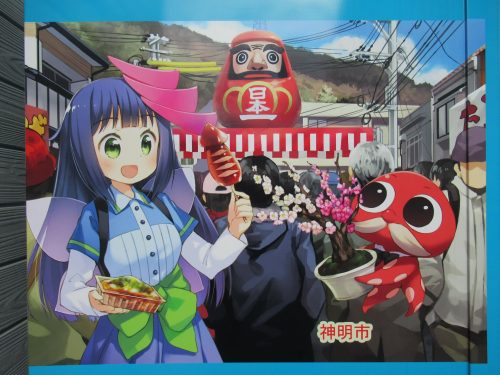
Mihara’s Shinmei-ichi Festival was conceived as a celebration dedicated to the Ise Grand Shrine in Mie Prefecture, which is venerated by the Japanese people as the holiest of all Shinto shrines in the land. There are centuries of history behind the Shinmei-ichi Festival, and Kobayakawa Takakage, the inaugural lord of the Mihara Domain and builder of Mihara Castle, cherished this festival dearly. What’s more, as seen from the illustration above, the Shinmei-ichi Festival takes place during plum blossom season and thus coincides with the arrival of spring. It was cancelled only from 2021-2023 on account of COVID-19, and this year, it was held for the first time in four years (it was held in 2020 right before the novel coronavirus was declared a pandemic; talk about a close shave). Just like before, hundreds of stalls and hundreds upon hundreds of people converged on the streets near the Mihara Castle Ruins to eat festival foods, buy daruma dolls, and bask in the joyous atmosphere.
South of Mihara Station
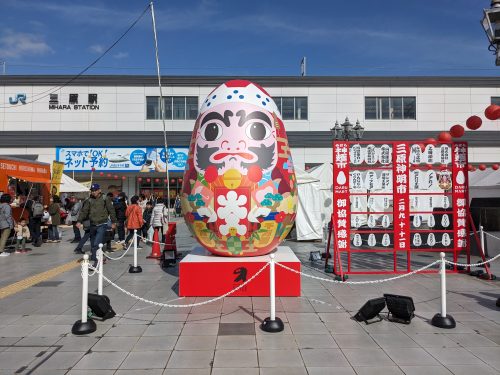
Mihara is roughly a one-hour train ride from Hiroshima Station on the Green Sanyo Line, sometimes with a transfer involved. Upon alighting my train and going down the stairs, I looked to my left and could already see the festival site from the station window. To be technical, the event occurring south of the station building is a separate gourmet-themed event that happens concurrently with Shinmei-ichi, but goes by a different name. This year, that name was “Shinmenchi (神麺地),” a portmanteau of the more important Shinmei-ichi (神明市) and the Japanese word for noodles, men (麺). As its name suggests, Shinmenchi was filled with food stalls specializing in noodles, from ramen to okonomiyaki to pasta. Additionally, there was a giant, inflatable daruma doll in the center of the plaza to greet the crowd and remind everyone of the reason for the occasion.
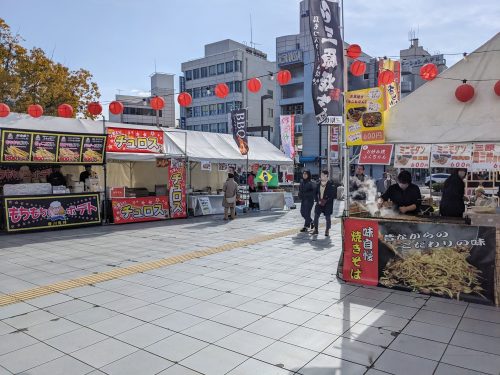
Of course, it wasn’t just noodles for sale, as there were also stalls selling churros, super-long French fries, Brazilian barbecue, among other delicacies. I was really tempted to try a miniature Mihara-style (stuffed with chicken offal) modan’yaki (Osaka-style okonomiyaki with noodles) but suppressed my desire in favor of finding something more cost-effective. Speaking of maximum bang for one’s buck (or lack thereof), the first food item I went for was a free sample of shiosoba (thin, yellow noodles in a clear, salt-based broth) being given out by Sora no Eki Orchard, a food and gift shop in Hattendo Village, a hilltop park in the vicinity of Hiroshima Airport.
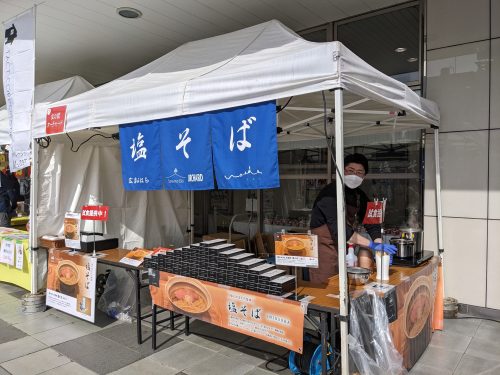
They were selling packs of shiosoba to take home rather than serving up full-size bowls for on-site dining, so to convince visitors to buy shiosoba, they were cooking up batches of noodles and rationing them in paper cups into which the salty broth was poured. Naturally, this meant that there was a rather long line to try this product, and it’s safe to say that the bulk of us had no intention of buying the noodles when we could have them for free, regardless of how tasty they were. On the whole, the line progressed rather quickly, and my advancement forward was interrupted only by the man having to boil a fresh batch of noodles. When I finally got my cup, I made my way to the adjacent tables, which served at standing eating space for anyone who bought anything at Shinmenchi. With my belly temporarily full from this tiny but yummy cup of shiosoba, it was time to worm my way to the actual Shinmei-ichi Festival site north of the station, but not without stopping inside the station building itself for another noteworthy point of interest.
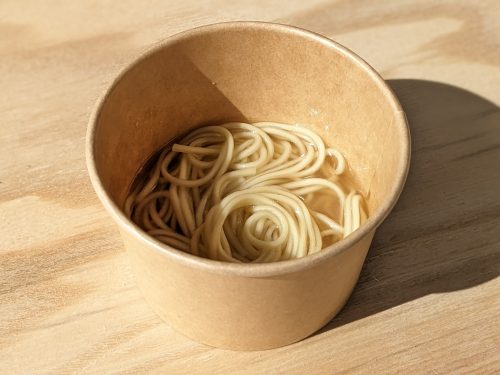
Place It and Pass It!
When I tried passing from one side of Mihara Station to the other, I came across a huge, temporary shrine inside the station building featuring a large, red octopus. I didn’t think much of it at the time because octopi are a common symbol of Mihara and I wanted to hurry to the Shinmei-ichi venue, but I learned a lot after the fact when I looked up the occasion behind this custom. It turns out that the Lucky Shrine inside Mihara Station was placed there not by the City of Mihara, but by the staff of Mihara Station itself on behalf of JR West. Since February is when high school seniors take entrance exams for their desired colleges and universities, the Lucky Shrine (らっきー神社) was assembled as a sign of encouragement for examinees, as well as an additional site where students can pray to ace their tests.
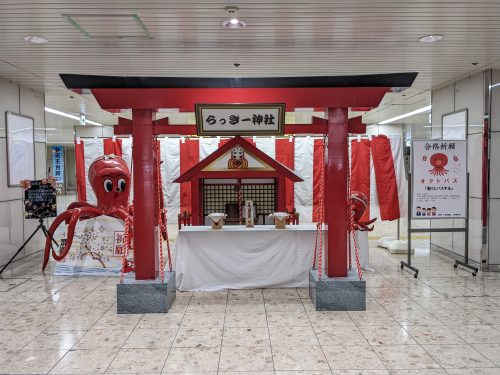
The mascot for the Lucky Shrine is a hachimaki-clad octopus named Okutopasu, which is a double entendre of the English word “octopus” and the Japanese phrase, “place it [somewhere] and pass [the exam] (置くとパス).” Students pick up a free paper talisman with Okutopasu on it, take it home, write the name of the school they’re trying to test into on the talisman, and leave it on their desk for the supposed spell to take effect. No one can say how effective these Okutopasu talismans are, but due to popular demand, the Lucky Shrine inside Mihara Station has been erected every February (yes, even during the pandemic) since 2011 so JR West must be doing something right. It runs through the entire month of February so it also coincides with the Hina Doll Festival display, in which some Hina dolls made of stone are placed on a shelf.
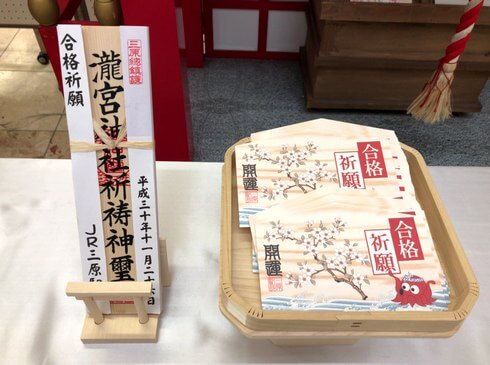
North of Mihara Station
The area north of Mihara Station and the Mihara Castle Ruins is where the Shinmei-ichi Festival earnestly begins, and is unsurprisingly the most festive part. Over 500 stands of vendors from all over the country were lined up on the streets that wrapped around the northern perimeter of the Mihara Castle Ruins and sprawled into the vicinity of the Ebisu Shrine northeast of Mihara Station. Besides food, there were stands featuring carnival games like shooting and scooping bouncy balls, plus the usual haunted house (possibly the same one that shows up at Hiroshima City’s Toukasan). One segment of the festival is reserved for a potted plant market of sorts, where sapling trees are lined up for visitors with green thumbs to take them home. Some trees have buds that will eventually open into flowers like peach blossoms or peonies, while others bear fruit such as loquats that are perfect for human consumption. Whether it is to be used now or later, there is something for everyone to buy at the Shinmei-ichi Festival.
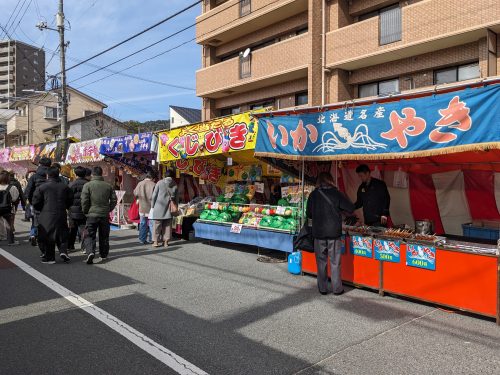
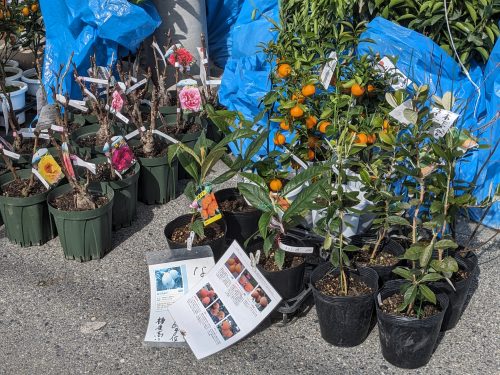
Straight as the crow flies, it’s about a 15-minute walk from one end of the stalls to the other but considering the crowds that day and all the cool stuff to see, none of us was walking at a normal pace. I spent more time looking at all the culinary option and debating what to eat than I spent actually munching on grub, but somewhere around the western end, I stopped inside a tent for some shrimp tempura udon because they actually had sit-down space.

Aside from the numerous stalls, the most quintessential landmark of the Shinmei-ichi is the largest daruma doll in all of Japan, which watches over all of the festival goers from a decorated metal rack. Weighing in at some 500 kilograms and standing at 3.9 meters tall with a diameter of 2.9 at its widest point, this big baby is the fourth incarnation of a long line of giant daruma dolls that was finished in January of 2013. The first one was made some time around 1950 by the Higashimachi District 4 Neighborhood Association to indicate the site where Darumakuji (daruma-themed paper fortunes) were being sold. Personally, I thought a daruma doll claiming to be the biggest in Japan would be more colossal, but I guess it may be too hard to elevate it if it got too big, plus there’s the danger of it falling. Considering the great placement of this ginormous doll on the eastern end of the festival site looking west towards all the spectators, perhaps this size is just right.

Speaking of Darumakuji, the site where people were buying them was indeed nearby. There was a bit of a crowd gathering around a tiny Ebisu shrine where people could instantly have their fortune told or buy a daruma doll to take home. The doll is usually sold with two blank eyes; the left eye is painted in by the owner after setting a goal to be accomplished within the year, and the right eye is painted in after said goal is achieved.
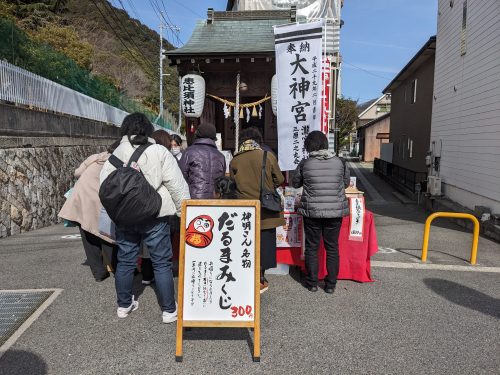
That shrine wasn’t the only place to buy daruma dolls, for there was another tent on a separate street further north full of daruma dolls and daruma paraphernalia. I was feeling stingy so I just got myself a pin badge featuring Yassa Daruman, the mascot for Mihara City, which came with assorted snacks.
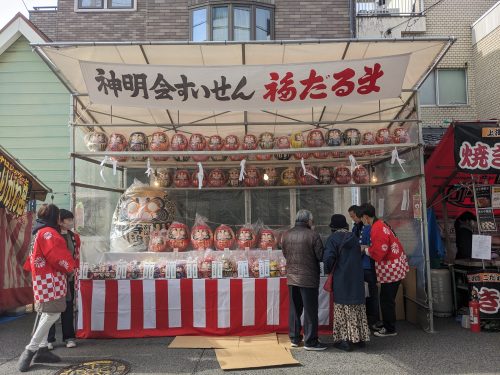
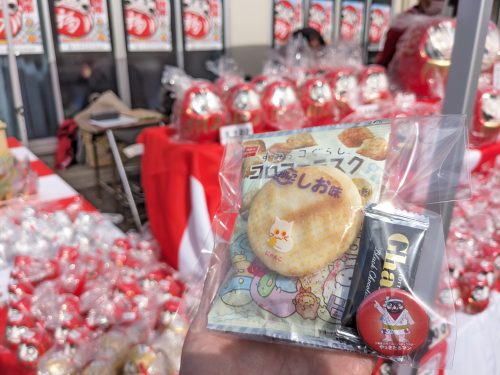
Moment of Joy: Mascot in the Flesh
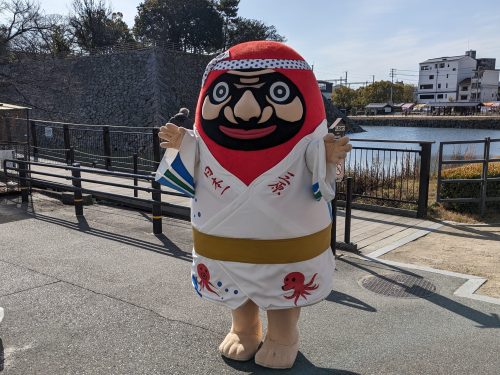
Speak of the festival mascot and he shall appear! The highlight of the Shinmei-ichi Festival for me was when I suddenly spotted Yassa Daruman in the flesh as I was walking in the direction of Mihara Station. Yassa Daruman also seemed to be fixing to retire for the day, but he and his lovely guide were still more than happy to let us take pictures of and with him. They honored my request for a photo with the ruins of Mihara Castle as the backdrop. The timing of this encounter could not have been luckier, and this moment augmented the festival feels just as I thought there was nothing more to see!
The Daruma Parade
The final event of the day was the Daruma Parade, in which local 3rd graders put on papier-mâché daruma costumes and walked down the main street of the festival site in the direction of the nation’s largest daruma doll. Virtually everyone, myself included, made sure to secure a comfortable and advantageous viewing spot before the parade began, but I soon realized there was only so much I could capture on camera were I to remain seated. The Daruma Parade started on time, and the kids in costume were among the first in the procession. Some looked happier to be there than others, but it was a long, slow march, and I applauded the effort they put in, plus they all looked so cute dressed as daruma!
It wasn’t just the kids in the parade either, since their parents and guardians were also by their side marching along to the music. Also present in the parade were the musicians that provided the tunes for the processions as well as a group of people carrying a palanquin.
That procession concluded the events of the first day of the Shinmei-ichi Festival (February 9th), which would continue over the weekend (the 10th and 11th) with similar events. With the Satsuki Festival in the spring, the Yassa Festival in the summer, the Ukishiro Festival in the fall, and the Shinmei-ichi Festival in the winter, Mihara truly has a major festival for every season! I’ve also found that the more festivals in Mihara I attend, the more I learn about the local history, which is a lot deeper than meets the eye. As for the daruma’s significance, the red dolls are a reminder for us to keep our eyes on the prize, and to get up every time life knocks us down, as stated by a Japanese proverb (七転び八起き – “fall seven times, rise eight times”). In fact, if at any point in the year I start to feel blue, all I have to do is make like a daruma, rebound and paint the town red at the next seasonal festival!
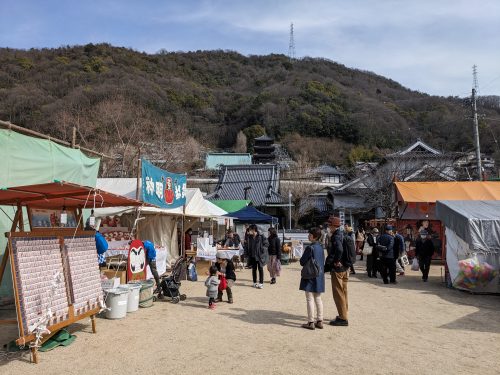
Written by the Joy in Hiroshima Team
